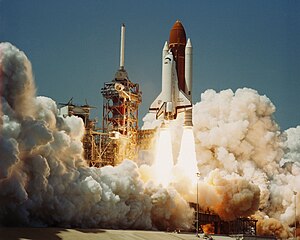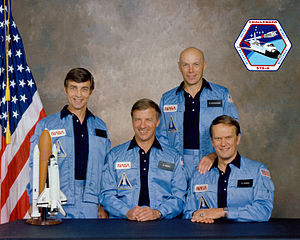
Back STS-6 Arabic STS-6 Bulgarian STS-6 Catalan STS-6 Czech STS-6 Danish STS-6 German STS-6 Spanish STS-6 Estonian استیاس-۶ Persian STS-6 Finnish
 Maiden launch of Challenger, April 4, 1983 | |
| Names | Space Transportation System-6 |
|---|---|
| Mission type | TDRS-A satellite deployment |
| Operator | NASA |
| COSPAR ID | 1983-026A |
| SATCAT no. | 13968 |
| Mission duration | 5 days, 23 minutes, 42 seconds (achieved) |
| Distance travelled | 3,370,437 km (2,094,292 mi) |
| Orbits completed | 81 |
| Spacecraft properties | |
| Spacecraft | Space Shuttle Challenger |
| Launch mass | 116,457 kg (256,744 lb) |
| Landing mass | 86,330 kg (190,330 lb) |
| Payload mass | 21,305 kg (46,969 lb) |
| Crew | |
| Crew size | 4 |
| Members | |
| EVAs | 1 |
| EVA duration | 4 hours, 17 minutes |
| Start of mission | |
| Launch date | April 4, 1983, 18:30:00 UTC |
| Rocket | Space Shuttle Challenger |
| Launch site | Kennedy Space Center, LC-39A |
| Contractor | Rockwell International |
| End of mission | |
| Landing date | April 9, 1983, 18:53:42 UTC |
| Landing site | Edwards Air Force Base, Runway 22 |
| Orbital parameters | |
| Reference system | Geocentric orbit[1] |
| Regime | Low Earth orbit |
| Perigee altitude | 288 km (179 mi) |
| Apogee altitude | 295 km (183 mi) |
| Inclination | 28.50° |
| Period | 90.40 minutes |
 STS-6 mission patch  Peterson, Weitz, Musgrave, Bobko | |
STS-6 was the sixth NASA Space Shuttle mission and the maiden flight of the Space Shuttle Challenger. Launched from Kennedy Space Center on April 4, 1983, the mission deployed the first Tracking and Data Relay Satellite, TDRS-1, into orbit, before landing at Edwards Air Force Base on April 9, 1983. STS-6 was the first Space Shuttle mission during which a Extravehicular activity was conducted, and hence was the first in which the Extravehicular Mobility Unit (EMU) was used.
© MMXXIII Rich X Search. We shall prevail. All rights reserved. Rich X Search